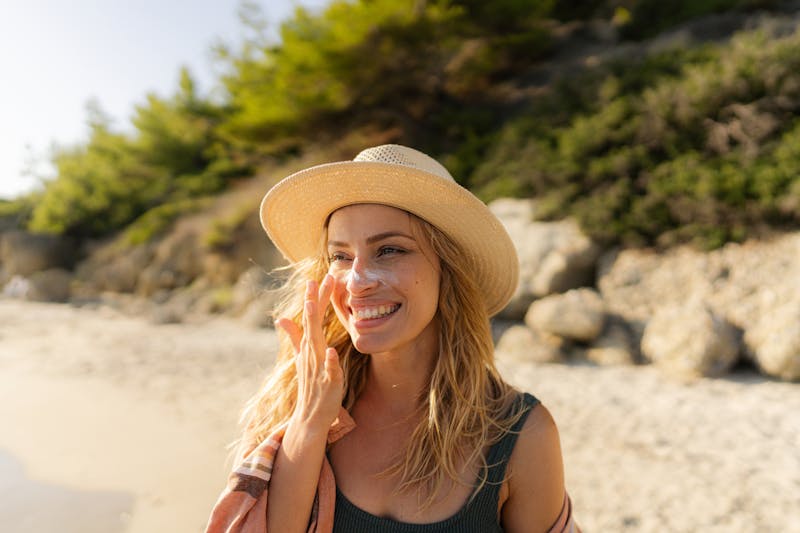
Skincare routines must be constantly evolving. They must change as skin matures, to address individual skin conditions, and as the weather changes. In our area, you may only need to adjust your skin for summer and winter. The tips below will help you create a tailored summer skincare routine.
Why Is Summer Skincare Important?
It’s easy to forget, but your skin is your body’s largest organ. It’s also a fully exposed organ. Even areas covered by clothing come in direct contact with potentially irritating external elements. Learning how to support and protect your skin year-round keeps it clear, healthy, and radiant.
Arizona summers are hot, dry, and sometimes humid. Your seasonal skincare adjustments are a key, and sometimes underestimated, part of anti-aging skincare routines. Your makeup, skincare products, and daily skincare routine will have a lot of overlap between summer and winter—but it will have some vital differences.
This is because:
- Your skin responds differently to heat and humidity.
- You’re more likely to sweat in the summer.
- You’re more likely to spend time in direct sunlight.
How Do I Care For My Skin in the Summer?
Before we dive into how to adjust your facial products for warmer weather, let’s dive into key changes for head-to-toe summer skin health.
UV protection
You should apply broad-spectrum UV protection 365 days a year. Even when it’s overcast, you’re exposed to UV rays. You’re even exposed to UV rays indoors, including the blue light of electronic devices and fluorescent lighting. However, the sun’s UV rays are more intense when the sun is shining bright. This increases the likelihood of sun damage, as you’re likely to spend more time outside in the spring and summer.
Few things age your skin more than sun damage. Not to mention the increased risk of skin cancer that comes with overexposure to the sun.
Standard SPF protection isn’t enough for your summer skincare routine. Broad-spectrum sunscreens filter both the sun’s rays and indoor ultraviolet rays. Apply UV protection in the morning and at least every 4 hours when indoors, and every 2 hours when outside. Use waterproof formulas when sweating.
Wear UPF clothing
The sun’s rays can penetrate clothing, so also consider what you’ll be wearing when in direct sunlight for extended periods. Look for clothing labeled “UPF”, which is short for “ultraviolet protection factor”.
All clothing filters some of the sun’s rays, but some garments are designed specifically to reflect light or absorb less light. When you wear UPF clothing, you must only apply sunscreen to the areas of your skin that are exposed.
Breathable and sweat-wicking clothing
Head out and go hiking and spend as much time outside this summer! When you expect to sweat, protect your skin with breathable and sweat-wicking clothing. The moisture of sweat, and the bacteria it grows over an extended period, can create a host of dermatological concerns. So, keep your skin as healthy as possible with clothing designed to keep you dry.
Hydrate
Dehydration is another factor that can leave your skin looking less than its best. Taking a proactive approach to hydration is something you must prioritize year-round, but it’s of greater importance when it’s hot or humid out. Hydration is an essential part of both summer skincare and whole-body health.
External hydration is often the first thing that comes to mind when we think of the skin, but healthy skin is both internally and externally hydrated. If you’re internally dehydrated, it doesn’t matter how much moisturizer you apply—it won’t resolve your dehydrated skin. If dehydration is prolonged, it can prematurely age your skin.
Since you’re likely to be sweating more during the summer, you need to proactively (or reactively) increase your water intake. So, drink more water, coconut water, sports drinks, and juice. Also, eat more smoothies, soups, and fruit to increase the water content in the foods you eat.
Is your skin dry not dehydrated? Since the air can be dry, consider using a humidifier. You can find compact desk and bedroom humidifiers.
Foot care
Keep your feet clean and dry by wearing breathable shoes and socks and sweat-wicking socks. You may want to have more frequent pedicures in the summer to keep your feet looking their best. Since your feet will be exposed, be sure to apply sunscreen and wear lotion socks with antioxidant-rich foot lotion a few days a week to keep your feet soft, moisturized, and beautiful.
How Does Internal Dehydration Impact Your Skin?
If you can’t identify the cause of the symptoms below, it may be a sign of internal dehydration. The longer these symptoms persist, the greater the likelihood of premature aging. Not to mention, the other health side effects of dehydration.
- Loss of elasticity—premature or rapid skin elasticity loss could be a lack of moisture. If your skin is dehydrated fine lines and wrinkles are more pronounced. Your skin may also sag or droop.
- Dull or uneven skin—if your skin has lost its glow, is dull, or your skin tone is uneven and isn’t improving with topical moisturizer, dehydration could be the cause.
- Increased sensitivity—if your skin is unusually sensitive to your regular skincare cleansers and skincare products, you must identify the cause. It could be dehydration, but it could be a variety of other dermatological issues.
- Enhanced oil production—this can be difficult to identify in the summer, because you may be sweating more. Also, the skin produces more sebum (an oily protective skin barrier) to help moisturize and cool skin. If your skin is producing more oil when indoors, it could be dry or dehydrated.
What Do I Put On My Skin in the Summer?
Now let’s dive into how to create a personalized summer skincare routine. You’ll likely need to cycle a few products out of your skincare routine for the next few months and cycle them back in as the weather cools down.
Continue to exfoliate 2 to 3 times a week and follow the 5-step AM/PM routine below. Also, apply a deep cleansing face mask and hydrating or functional face masks as needed.
- Cleanse
- Tone
- Serum
- Moisturize
- UV sun protection
Utilize the tips below for personalizing your summer skincare routine.
#1 Reconsider Your Cleanser
If you aren’t yet, you may want to switch to a facial cleanser with salicylic acid. This will help with summer oil control. If you’re wearing lighter makeup, you may also want to switch to an ultra-gentle or foaming cleanser.
#2 Toner
Continue to tone your skin, maybe switching to a calming or soothing formula that includes rosewater or chamomile. If your summer cleanser doesn’t contain salicylic acid, you could apply a toner with salicylic acid.
#3 Antioxidant-Rich Serum
It’s never too early to start using skincare serums, but you don’t have to start using them daily until the initial signs of aging begin. That said, during the summer months, you may want to use them at least in the evening. With their high antioxidant content, they can help to reverse and repair summer skin damage.
#4 Switch to a Lighter Moisturizer
In the winter, a thicker moisturizer provides all-day moisture and a protective skin barrier. Using the same moisturizer in the summer may feel thick and heavy. It can make your face look shiny and make your makeup run. So, consider a lightweight formula in the summer. You may also want to switch to a lighter-weight body lotion.
#5 Broad-Spectrum Sunscreen
Sunscreen isn’t just for summer skincare, as it should be utilized year-round. Prioritize moisturizers and makeup that include sunscreen, but also consider layering a dedicated sunscreen between your moisturizer and your makeup. Reapply every 4 hours when indoors and every 2 hours when outside. This can be an additional layer of UV makeup, a UV cream, or spray-on sun protection.
Don’t forget to apply lip care products with sunscreen in the summer, and year-round!
#6 Makeup
You might use the same makeup products in the summer, but you may also want to make a few changes.
This might include switching to or using:
- A lightweight foundation for lighter coverage.
- A tinted moisturizer with broad-spectrum protection.
- Cream blush and eyeshadows that run less than powders.
- Primers, powders, and setting sprays to keep makeup on.
- Waterproof mascara and sweatproof products.
- Facial mist and blotting sheets to minimize oil.
How to Repair Summer Sun Damage?
Sun can damage the skin at the cellular level, slowing the rate of collagen production. Even mild overexposure can lead to hyperpigmentation and premature fine lines and wrinkles. One way to repair and reverse some of your sun damage is with medical spa treatments.
Valley Medical Weight Loss and Med Spa offers a range of anti-aging skincare treatments to rejuvenate your skin by stimulating collagen production and cellular repair. Which treatment is right for you depends on the full spectrum of skin conditions you want to treat.
Schedule a skin consultation today as a part of your proactive summer skincare. We’ll assess your skin and advise on which of our restorative treatments can revitalize your skin!

